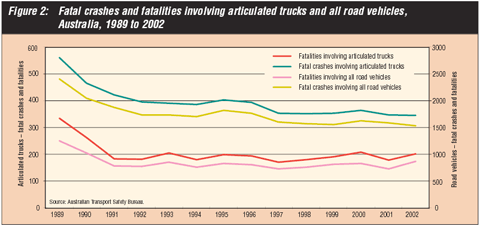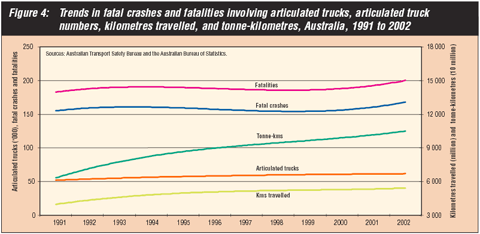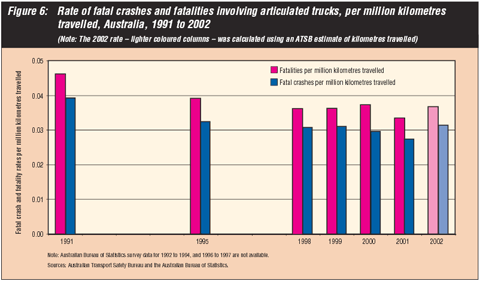Summary
This monograph presents national data on fatal crashes and fatalities that involved an articulated truck. Fatalities include truck occupants, motorcyclists, bicyclists, other vehicle occupants and pedestrians. The data are the most recent that were available for analysis in May 2003.
Key findings
- The number of fatal crashes and fatalities involving articulated trucks peaked in the late 1980s.
- By 1991 the number of crashes and fatalities had dropped significantly.
- Since 1991 the number of crashes and fatalities have remained relatively stable.
- Activity levels in the road transport industry rose significantly between 1991 and 2001:
- articulated truck numbers increased by 18 per cent;
- kilometres travelled increased by 34 per cent; and
- tonne-kilometres increased by 62 per cent.
- The fatality rate per kilometre travelled declined by about 20 per cent between 1991 and 2002.
- The fatality rate per tonne-kilometre declined by about 30 per cent between 1991 and 2002.
- Articulated truck drivers were assessed by coroners as being either fully or partially at fault in about 25 per cent of multiple vehicle fatal crashes involving articulated trucks in 1999.
- Recent data indicate that approximately 25 per cent of fatal crashes involving articulated trucks were single vehicle crashes.



General trends
After a substantial increase during 1988, both fatal crashes and fatalities involving articulated trucks had dropped well below previously recorded figures by 1991 (fig. 1).
Fatal crashes dropped from a peak of 260 in 1988, to 156 in 1991 a decrease of 40 per cent.
Fatalities dropped from a peak of 335 in 1989, to 183 in 1991 a decrease of 58 per cent.
Overall, between 1991 and 2002, there was no statistically significant change in the level of fatalities or fatal crashes involving articulated trucks (table 1).
A comparison of the curves for fatal crashes and fatalities involving articulated trucks against the equivalent curves for all vehicles indicates that, apart from 2002, the peaks and troughs largely mirrored each other (fig. 2).
Level of truck activity, 1991 to 2001 The year 2001 is the most recent for which Australian Bureau of Statistics, Survey of Motor Vehicle Use data are available. While fatal crashes and fatalities involving articulated trucks remained relatively stable between 1991 and 2001, articulated truck numbers, kilometres travelled, and tonne-kilometres all increased (fig. 3). Overall, between 1991 and 2001:
- articulated truck numbers increased by 18 per cent;
- kilometres travelled by articulated trucks increased by 34 per cent; and
- articulated truck tonne-kilometres increased by 62 per cent.

Trend lines
Figures 4 and 5 reflect polynomial cubic trend lines (ie. to the order of 3) for data in table 1.
Although fatal crashes and fatalities indicate an upward swing at the end of 2002, on the whole, their trend lines for 1991 to 2002 are relatively flat (fig. 4). Trend lines for tonnekilometres, kilometres travelled and articulated truck numbers all show a continual rise throughout the period.
Significant increases in both average tonnekilometres and average kilometres travelled per articulated truck were recorded in the first half of the 1990s, and then remained fairly steady until another noticeable increase in 1999. A considerable proportion of the rise recorded in both average kilometres travelled and average tonne-kilometres in 2000 was reversed in 2001. Overall, average tonnekilometres rose at a greater rate than average kilometres travelled, indicating that articulated trucks were carrying increasingly greater loads than they did at the beginning of the 1990s (fig. 5). In fact, between 1991 and 2001, while average kilometres travelled by articulated trucks increased by 34 per cent, tonnekilometres increased by 62 per cent.


Fatality rates
Between 1991 and 1995, improvements are evident in the fatal crash rates and fatality rates involving articulated trucks (fig. 6). The fatal crash rate fell from 0.039 to 0.032 per million kilometres travelled, while the fatality rate fell from 0.046 to 0.039.
After this period the rate remained relatively constant until 2001, when there was a further noticeable improvement: the fatal crash rate dropped to 0.027 and the fatality rate dropped to 0.033. ATSB estimates of the 2002 rates indicate a reversal of the improvements gained in 2001.
Crash characteristics
The majority of fatal crashes involving articulated trucks occurred between a truck and another vehicle and in non-urban areas.
In 2000, single-vehicle crashes accounted for approximately 25 per cent of fatal crashes involving articulated trucks.
Data for 1999 indicate that articulated truck drivers were assessed by coroners as being fully responsible for the crash in about 20 per cent of multiple-vehicle fatal crashes, and either fully or partially responsible in about 25 per cent of multiple-vehicle crashes.
The number of fatalites involving articulated trucks has averaged out at about 190 per year over the last decade.
Between 1991 and 2002 the fatality rate per kilometre travelled fell by about 20 per cent, and the fatality rate per tonne-kilometre fell by about 30 per cent.
In summary, the number of fatal crashes and fatalities involving articulated trucks has remained relatively stable since the early 1990s, although the fatal crash and fatality rates per distance travelled has declined as a result of substantial increases in trucking activity over the same period.

Download Complete Document: Truck_Crash_5 [ PDF: 83 KB]
PDF: 83 KB]
Type: Research and Analysis Report
Sub Type: ATSB Monograph
Topics: Fatality, Heavy vehicle, Statistics
Publication Date: 01/04/03
Related Links: Ministerial Media Release